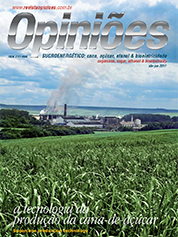Frederico Ozanan Machado Durães
Head of Embrapa Agroenergia
Op-AA-28
The reformation and sorghum
The sugarcane business in Brazil has been continuously updated, as the result of the competitiveness of markets. There is a continuous quest for efficiency, productivity and sustainability. In all phases of the sugarcane production process, certain requirements must be met: business governance, use of technical and scientific knowledge, and cooperative initiatives aimed at results and impacts.
The periodic reformation of sugarcane agriculture is a complex activity that implies mandatory agronomic practice, tied to the logic of the processing industry, and varies with the continuous requirements of economic results. Pests and plant diseases and the infestation of soil through invader plants, as well as opportunities for new production scenarios, improvement of soil quality, use of residual fertilizers, interruption of pathogenic cycles or reduction of sources of inoculation, in addition to economic criteria that express the cost/benefit relation of rotating cultures, or even the cost of land, are relevant practices among the factors that determine the choice of time and operations for the reformation of sugarcane plantations.
To that end, there is no single formula, even though at the level of individual properties one seeks to find, and at the regional level one observes, preferred procedures for the reformation of sugarcane plantations. Oily crops (peanuts, sunflower, soybeans) and green fertilizers (Crotalaria juncea L.) are common species in reformation areas.
Studies on the reformation of sugarcane plantations have shown the complexity of criteria for defining the interruption stage of the production cycle. Productivity in each cutting in each lot has been used as the indicator of reformation. Generally speaking, observed productivities between 135 and 55 t/ha of sugarcane, between the first and the sixth year of the production cycle, show 60 t/ha and the sixth year as critical for replacing a sugarcane plantation.
Reformation requires the beforehand definition of strategy and practices for the implementation of new agricultural activities. The sugarcane-based industry’s competitiveness tends to maximize the use of land due to increases in productivity and relations based on technical and economic criteria.
The increase in supply of new modified cultures, characterized by specificity and precociousness in genotype-environment relations, tends to shorten the crop’s production cycle, whereas reformation alternatives will go new routes to production arrangements, of interest for agriculture and industry, at the regional level.
One of the alternatives for the reformation or replacement of sugar-cane plantations surely would seek to incorporate the culture of sorghum into production systems for food and energy. Sorghum will certainly expand in many sugarcane and non sugarcane planting regions throughout Brazil.
Saccharine sorghum, a type of Sorghum bicolor (L.) Moench, with high forage potential, has stalks containing juice similar to those of sugarcane, rich in fermentable sugars, which may be suited for the production of ethanol in the same facility used for sugarcane.
This occurs in a fast cycle (four months), it is an operation that can be totally mechanized (seed planting, crop treatment and harvesting), high green biomass productivity (60 to 80 t/ha), with high ethanol outputs (3,000 to 6,000 l/ha), with bagasse usable as a source of energy or as forage for livestock, contributing to a favorable energy balance. In addition, saccharine sorghum produces beans (2 to 5 t/ha), that have nutritional characteristics similar to those of corn, and may be used in feeding humans or livestock.
Technical data shows the possibilities of producing ethanol from saccharine sorghum during the sugarcane offseason. Planting carried out in the beginning of the rain season (Oct/Nov) makes it possible to anticipate crushing in the mills by 2 to 3 months, with harvesting taking place beginning in February and March, thereby reducing the idle period in distilleries, which varies from 3 to 5 months, with impact on the generation of revenue.
The Embrapa Corn and Sorghum team developed culture BRS 506, which has good adaptability to several edaphoclimatic conditions in Brazil. It also described the culture’s characteristics and set agronomic, technical and economic criteria for good practices in managing this species.
Public Private Partnerships develop initiatives seeking to optimize saccharine sorghum production systems, mainly in sugarcane plantation areas undergoing renovation, and also assess their industrial productivity. One observes results ranging from 50 to 77 liters of ethanol per ton of green mass with TRS (total recoverable sugars) varying from 80 to 127 kg of extracted sugar per ton of green mass, using the same technology applied in mills.
Furthermore, one observes that it is possible to adjust the same structure for harvesting and processing biomass used for sugarcane. In summary, from the agronomic and industrial point of view, the saccharine sorghum crop has great potential for the reformation of sugarcane plantations.
Studies show that one looks for options to reform 10-15% of sugarcane areas per year, so as to amortize about 30-40% of the cost of implementing a new sugarcane plantation. When carrying out the reformation, the rotation of cultures improves a sugarcane plantation’s productivity by up to 20%. The selection of economically relevant species must contribute to satisfying the interest of producing food and energy.




